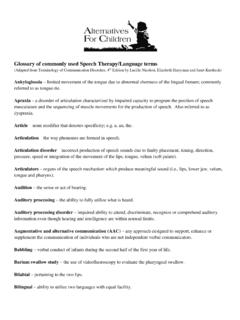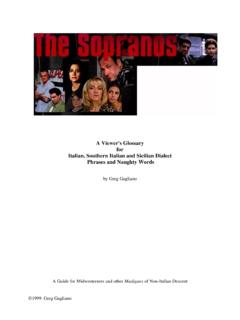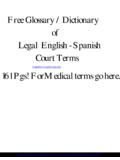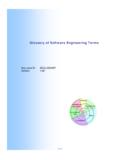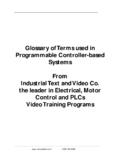Transcription of Glossary of commonly used Occupational Therapy …
1 Glossary of commonly used Occupational Therapy terms Adaptive Response: An action that is appropriate and successful in meeting some environmental demand. Adaptive responses demonstrate adequate sensory integration and drive all learning and social interactions. Auditory: Language processing skills: the abilities of listening and verbally communicating, acquired as on hears and perceives sounds and interacts with the environment. Auditory Figure-Ground: The ability to discriminate between sounds in the foreground and background, so that one can focus on a particular sound or voice without being distracted by other sounds. Auditory Perception: The ability to receive, identify, discriminate, understand and respond to sounds.
2 Bilateral Coordination: The ability to use both sides of the body together in a smooth, simultaneous, and coordinated manner. Bilateral Integration: The neurological process of integrating sensations from both body sides; the foundation for bilateral coordination. Binocularity (Binocular Vision; Eye Teaming): Forming a single visual image from two images that the eyes separately record. Body Awareness: The mental picture of one s own body parts, where they are, how they interrelate, and how they move. Cocontraction: All muscle groups surrounding a joint contracting and "working" together to provide that joint stability resulting in the ability to maintain a position. Depth Perception: The ability to see objects in three dimensions and to judge relative distances between objects, or between oneself and objects.
3 Directionality: The awareness of right/left, forward/back, and up/down, and the ability to move oneself in those directions. Discriminative System: The component of a sensory system that allows one to distinguish differences among stimuli. This system is not innate but develops with time and practice. Dyspraxia: Deficient motor planning that is often related to a decrease in sensory processing. Eye-Hand Coordination: The efficient teamwork of the eyes and hands, necessary for activities such as playing with toys, dressing, and writing. Equilibrium: A term used to mean balance. Extension: A straightening action of a joint (neck, back, arms, legs). Fight-Or-Flight Response: The instinctive reaction to defend oneself from real or perceived danger by becoming aggressive or by withdrawing.
4 Figure-Ground Perception: The ability to perceive a figure in the foreground from a rival background. Fine Motor: Referring to movement of the muscles in the fingers, toes, eyes and tongue. Fine Motor Skills: The skilled use of one s hands. It is the ability to move the hands and fingers in a smooth, precise and controlled manner. Fine motor control is essential for efficient handling of classroom tools and materials. It may also be referred to as dexterity. Fixation: Aiming one's eye at an object or shifting one's gaze from one object to another. Flexion: A bending action of a joint or a pulling in of a body part. Focusing: Accommodating one's vision smoothly between near and distant objects. Form Constancy: Recognition of a shape regardless of its size, position, or texture.
5 Gravitational Insecurity: Extreme fear and anxiety that on e will fall when one s head position changes. Gross Motor: Movements of the large muscles of the body. Gross Motor Skills: Coordinated body movements involving the large muscle groups. A few activities requiring this skill include running, walking, hopping, climbing, throwing and jumping. Habituation: The neurological process of tuning out familiar sensations. Hand Preference: Right - or lefthandedness, which becomes established in a child as lateralization of the cerebral hemispheres develops. Hypersensitivity: (also Hyper-reactivity or Hyper-responsiveness). Oversensitivity to sensory stimuli, characterized by a tendency to be either fearful and cautious, or negative and defiant.
6 Hypersensitivity to Movement: A sense of disorientation and/or avoidance of movement that is linear and/or rotary. Hyposensitivity: (also Hyporeactivity or Hyporesponsiveness). Undersensitivity to sensory stimuli, characterized by a tendency either to crave intense sensations or to withdraw and be difficult to engage. Inner Drive: Every person's self-motivation to participate actively in experiences that promote sensory integration. Integration: The combination of many parts into a unified, harmonious whole. Kinesthesia: The conscious awareness of joint position and body movement in space, such as knowing where to place one s feet when climbing stairs, without visual cues. Lateralization: The process of establishing preference of one side of the brain for directing skilled motor function on the opposite side of the body, while the opposite side is used for stabilization.
7 Lateralization is necessary for establishing hand preference and crossing the body midline. Linear movement: A motion in which one moves in a line, from front o back, side to side, or up and down. Low Tone: The lack of supportive muscle tone, usually with increased mobility at the joints; the person with low tone seems loose and floppy . Midline: A median line dividing the two halves of the body. Crossing the midline is the ability to use on side or part of the body (hand, foot, or eye) in the space of the other side or part. Modulation: The brain's ability to regulate it's own activity. Motor Control: The ability to regulate and monitor the motions of one s muscle group to work together harmoniously to perform movements.
8 Motor Coordination: the ability of several muscles or muscle groups to work together harmoniously to perform movements. Motor Planning: The ability to conceive of, organize, sequence, and carry out an unfamiliar and complex body movement in a coordinated manner, a piece of praxis. Muscle Tone: The degree of tension normally present when one s muscles are relaxed, or in a resting state. Oscillation: Up and down or to and fro linear movement, such as swinging, bouncing, and jumping. Perception: The meaning the brain attributes to sensory input. Plasticity: The ability of the brain to change or to be changed as a result of activity, especially as one responds to sensations. Position in Space: Awareness of the spatial orientation of letters, words, numbers, or drawings on a page, or of an object in the environment.
9 Postural Adjustments: The ability to shift one's body in order to change position for a task. Postural Insecurity: A fear of body movement that is related to poor balance, and deficient "body-in-space" awareness. Postural Stability: Being able to maintain one's body in a position to efficiently complete a task or demand, using large muscle groups at the shoulders and hips. Praxis: The ability to interact successfully with the physical environment; to plan, organize, and carry out a sequence of unfamiliar actions; and to do what one needs and wants to do. Praxis is a broad term denoting voluntary and coordinated action. Motor planning is often a used as a synonom. Prone: A horizontal position of the body where the face is positioned downward.
10 Proprioception: The unconscious awareness of sensations coming from one s joints, muscles, tendons, and ligaments; the position sense . Receptive Language: The ability to understand how words express ideas and feelings; language that one takes in by listening and reading. Rotary Movement: turning or spinning in circles. Self-Help Skills: Competence in taking care of one's personal needs, such as bathing, dressing, eating, grooming, and studying. Self-Regulation: The ability to control one s activity level and state of alertness, as well as one s emotional, mental or physical responses to senses; self-organization. Sensorimotor: pertaining to the brain-behavior of taking in sensory messages and reacting with a physical response.
